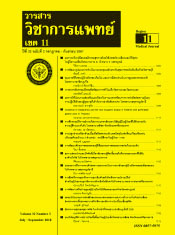Effects of balance training on balance in patients with stroke Suratthani Hospital
Keywords:
Stroke patients, Balance training, BalanceAbstract
is very important in patients with stroke. However, when
comparing between the only physical therapy training and balance
with physical therapy training it can effect the ability of the balance
in patients with stroke is not clear. This study aimed to study the
effect of balance training on balance ability in patients with stroke.
Methods: Patients with stroke receiving physical therapy at
Suratthani hospital. Forty patients aged between 40-70 years had the
muscles power of the weakness side of grade 3 and above, having
no history of tumors, bone fractures, Thai massage and have been
treated physical therapy before. Patients with stroke were divided
into two group’s compare before and after and between groups
(Group 1 was the group receiving physical therapy training of 60
minutes, Group 2 was the group receiving physical therapy training
of 30 minutes with an balance training program of 30 minutes,
including 60 minutes) 3 days per week for 3 consecutive months.
Results: Thirty-two patients with stroke were randomized
to receive physical therapy program is 15 , including 10 males, 5
females, and a group of physical therapy with balance training
program is 17 people were 8 males, 9 females. This study
determined the physical therapy and physical therapy with balance
groups significantly increases balance training compared to the
pre-treatment. While comparison between groups demonstrates
that post training no statistically significant compared to the pretreatment
in patients with stroke.
Conclusion: The results of this study show that the balance
training program and physical therapy training programs have
increase balance in patients with stroke
References
Hanchaiphiboolkul S, Poungvarin N, Nidhi- nandana S, Suwanwela NC, Puthkhao P, Towanabut S, et al. Prevalence of stroke and stroke risk factors in Thailand: Thai Epidemiologic Stroke (TES) Study. Journal of
the Medical Association of Thailand = Chotmaihet thangphaet; 2011;94(4): 427-36.
Carla P, Anabela C, Marta A, Daniel V. Effects of oculomotor and gaze stability exercises on balance afterstroke: Clinical trial protocol. Porto Biomed J; 2017;3(2): 76-80
Powers WJ, Rabinstein AA, Ackerson T, Adeoye OM, Bambakidis NC, Becker K, et al. 2018 Guidelines for the Early Management of Patients With Acute Ischemic Stroke: A Guideline for Healthcare Professionals From the American Heart Association/American Stroke Association. Stroke; a journal of cerebral circulation; 2018; 49(3):e46-e110.
Schinkel-Ivy A, Wong JS, Mansfield A. Balance Confidence Is Related to Features of Balance and Gait in Individuals with Chronic Stroke. Journal of stroke and cerebrovascular diseases : the official journal of National Stroke Association; 2017;26(2):237-45.
Liu TW, Ng GYF, Ng SSM. Effectiveness of a combination of cognitive behavioral therapy and task-oriented balance training in reducing the fear of falling in patients with chronic stroke: study protocol for a randomized controlled trial. Trials. 2018; 7;19(1):168
Carolee J. Winstein JS, Ross Arena LRC,Steven C. Cramer BF, Richard L. Harvey MM-L, Kenneth J. Ottenbacher MJR, Lorie G. Richards, et al. A Guideline for Healthcare Professionals From the American Heart Association/American Stroke Association. Guidelines for Adult Stroke Rehabilitation and Recovery; 2016;30
(27):e98-e169
Schinkel-Ivy A, Inness EL, Mansfield A. Relationships between fear of falling, balance confidence, and control of balance, gait, and reactive stepping in individuals with sub-acute stroke. Gait & posture; 2016;43:154-9
Tilson JK, Wu SS, Cen SY, Feng Q, RoseDR, Behrman AL, et al. Characterizing and identifying risk for falls in the LEAPS study: a randomized clinical trial of intervent ions to improve walking poststroke. Stroke; a journal of cerebral circulation; 2012;43(2):446-52
Cho K, Yu J, Rhee H. Risk factors related to falling in stroke patients: a cross- sectional study. Journal of physical therapy science; 2015;27(6):1751-3
นพพล ประโมทยกุล, อรณิชา ยางงาม, ณัฐธยาน์ สัจจาภิบาลธรรม, แก้วเทพ. ป. ผลของการฝึกการทรงตัวด้วยการป้อนข้อมูลกลับผ่านทางสายตาโดยใช้โทรศัพท์มือถือแบบสมาร์ตโฟนที่มีผลต่อความสามารถในการยืนทรงตัวของผู้ป่วยโรคหลอดเลือดสมอง:การศึกษานำร่อง: Effect of balancetraining by smartphone visual feedback on standing balance in patients with stroke:pilot study. ภาควิชากายภาพบาบัดคณะสหเวชศาสตร มหาวิทยาลัยธรรมศาสตร์;2560; 39 (1):1-12.
Veerbeek JM, van Wegen E, van Peppen R, van der Wees PJ, Hendriks E, Rietberg M,et al. What is the evidence for physical therapy poststroke? A systematic review and meta-analysis. PloS one; 2014;9
(2):e87987.
Lacroix A, Kressig RW, Muehlbauer T,Gschwind YJ, Pfenninger B, Bruegger O, et al. Effects of a Supervised versus an Unsupervised Combined Balance and Strength Training Program on Balance and Muscle Power in Healthy Older Adults: A Randomized Controlled Trial. Gerontology; 2016;62(3):275-88
Rabadi MH. Review of the randomized clinical stroke rehabilitation trials in 2009. Medical science monitor : international medical journal of experimental and clinical research; 2011;17(2):RA25-43






